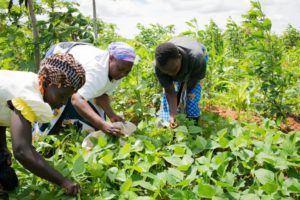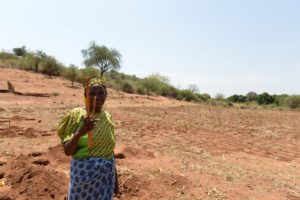
Despite challenges from both the land and society, women in Kenya are taking control of their farms, with impressive results. Following a previous article on the topic, we delve deeper into a farming technique that is alleviating food shortages in the country.
Agricultural innovations in Africa aimed at improving the productivity of smallholders, especially women, are necessarily subject to accommodating multiple needs, which in turn depend on differing priorities, preferences and access to resources.
Renting an ox-drawn plough, for example, operated by able-bodied men, is a financial challenge for many farmers, particularly the women who make up the majority of farmers in the drylands of what is known as Kambaland in southeastern Kenya.
“It is too expensive to rent the bulls and pay for the young men,” said Veronicah Ngau of Mutembuku village, Makueni County. “Even if I beg someone for free help I have to wait until they are finished with their own work.”
She gave up on ox-drawn tilling after experiencing three rounds of stunted crops. She explained that technologies like terracing and sunken-bed kitchen gardens, however, had improved the situation.
The farmers achieved stark differences in yields with simple planting basins, a water-conservation technology. The basins, which are being modified and tested in several countries, are part of a partnership between farmers, the World Agroforestry Centre (ICRAF), World Vision, Adventist Development and Relief Agency, Caritas Internationalis and governments. ICRAF, a CGIAR Research Program on Forests, Trees and Agroforestry (FTA) partner organization, is leading the research component.
Preliminary results show that the size of the basins and their combination with other practices, such as applying manure and mulching, determine their impact on maize production under different conditions.
Read more: Picks and spades can triple farmers’ yields in Kenyan drylands

But what are perhaps more difficult to accurately assess are the implications for labour and time. A 60 x 60 cm pit, for example, takes about an hour for a woman in her fifties, like Ngau, to prepare. Like many of her neighbors, she does not have children at home to help.
That led them to convene a group of 10 women from the project’s community of practice to collectively dig three pits a week at each other’s homes.
Ngau’s success was enabled by the existence of the community of practice and her ability to mobilize her peers to work together. These factors are likely to vary between farmers and communities and will determine the success or failure of the technology.
An additional issue is women’s right to make decisions about their farms. Evidence shows that traditional gender norms and roles, as well as tenure rights, can limit women’s participation in decision-making about the use of land. But it seems that the migration of men, combined with the success witnessed by some of the participating farmers, has influenced decision-making dynamics at the project sites.
“We didn’t even have to ask our husbands for permission,” said Mary, another farmer in Machakos County. “Our husbands are not concerned with food production. They are mostly away and when they do have an opinion on where tree seedlings should be planted, for example, we allow them to choose their space first then we plant in our own choice of space.”
Most of the men are typically engaged with livestock and poultry trading or have migrated to earn a better living. Producing food therefore rests on women’s shoulders. Amid the land degradation and changes in climate that have lead to food shortages, the planting basins have helped to improve the women’s farming outcomes.
Community facilitators engaged with the projects have observed, however, that even from afar the male heads of households still have the final say on what is done with the land, including the digging of basins. But once they give consent for a plot to be used for planting basins, the women take over all other management decisions.
An in-depth study is currently underway to assess how this and other land restoration technologies can change gender dynamics, considering the social context and the specific challenges that female and male farmers face in using them.
Read more: Enhancing how trees and forests contribute to smallholder livelihoods
By Ana Maria Paez-Valencia, originally published at ICRAF’s Agroforestry World.
The planting basins are part of a project funded by the European Union and the International Fund for Agricultural Development on restoring land for food security, which complements the Netherlands-funded Drylands Development Programme.
This research is part of the CGIAR Research Program on Forests, Trees and Agroforestry (FTA), which is supported by CGIAR Fund Donors.











